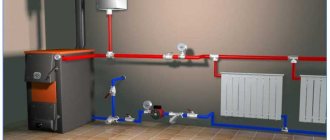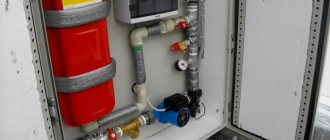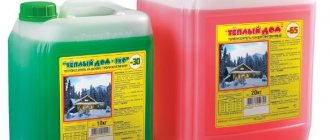We know that geothermy is the heat of the Earth, and the concept “geothermal” is often associated with volcanoes and geysers. In Russia, geothermal energy is used primarily on an industrial scale; for example, there are Far Eastern power plants that operate using the heat of our planet.
Many people are sure that making geothermal heating at home with their own hands is something out of science fiction. Is not it? But this is absolutely not true! With the development of modern technologies, the domestic use of “green energy” has become quite possible.
We will talk about the operating principles of alternative heating, its advantages and disadvantages, and compare it with traditional heating systems. You will also learn about how to position the heat exchanger and how to install geothermal heating with your own hands.
A few historical facts
When the oil crisis broke out in the 70s of the last century, a burning need for alternative energy sources arose in the West. It was at this time that the first geothermal heating systems began to be created.
Today they are widespread in the United States, Canada and Western European countries.
Image gallery
Photo from
Prospects for geothermal heating
Dimensions of the indoor unit of the geothermal system
Cost of installation and operation of a heat pump
Environmental priorities of heat pumps
For example, in Sweden they actively use water from the Baltic Sea, whose temperature is +4°C. In Germany, the introduction of geothermal heating systems is even sponsored at the state level.
When we mention geothermal energy sources, we always imagine a valley of geysers or volcanoes, but the sources we need are much closer. And they will help us stay warm in winter and cool in summer.
In Russia there are Pauzhetskaya, Verkhne-Mutnovskaya, Okeanskaya and other geothermal power plants. But there is very little evidence of the use of Earth's energy in our private sector.
History of appearance
The main reason for the appearance of such heating systems for cottages is the energy crises that took place in the 70s of the last century. Initially, only the most elite and wealthy families allowed themselves to install an innovative heating system from the ground.
Subsequently, thanks to the gradual development of science and technology, as well as the emergence of new technologies, such systems became more widespread, because their acquisition cost was constantly decreasing.
A geothermal heating system is now available to average-income families without breaking the bank. Improvement and modernization of geothermal equipment is still being carried out, since the installation of new units leads to a reduction in energy consumption and large savings.
About geothermal heating sources
The following sources of terrestrial thermal energy can be used for geothermal heating:
- high temperature;
- low temperature.
High-temperature ones include, for example, thermal springs. They can be used, but their scope is limited by the actual location of such sources.
While in Iceland this type of energy is actively used, in Russia thermal waters are located far from populated areas. They are concentrated to the maximum in Kamchatka, where underground water is used as a coolant and supplied to hot water systems.
To effectively use the earth's thermal energy, you do not need a volcano. It is enough to use those resources that are located just 200 meters from the earth’s surface
But we have all the necessary prerequisites for the use of low-temperature sources. The surrounding air masses, earth or water are suitable for this purpose.
A heat pump is used to extract the required energy. With its help, the procedure is carried out to convert the ambient temperature into thermal energy not only for heating, but also for hot water supply to a private household.
Image gallery
Photo from
Absorption of free heat from groundwater and rocks
External heat exchanger of the earth-water system
External heat exchanger in a natural reservoir
Geothermal Well Heat Pump
Payback of geothermal heating at home
All financial expenses during the installation of equipment and the entire geothermal heating system depend on the type of refrigerant used, the level of efficiency, the power of the unit and its manufacturer. The choice of brand is an individual decision of the home owner. The power of the heat pump, in turn, is determined not by desire, but by the overall square footage of the premises. The price of the installed equipment depends on this. On average, it is several orders of magnitude higher than that of heating boilers. The cost of installation itself is added to this amount.
The result is a fairly high figure, which scares many users. However, it pays off in a minimum of 5-7 years and a maximum of 15. The practice of using geothermal heating shows that this heating method makes sense for cottages with an area of about 150 square meters. meters. They get enough heat and pay for themselves much earlier.
The efficiency and economic profitability of a geothermal design is much higher if the external circuit does not pass through dry soil, but through a thermal source. But in this case, it is necessary to separate the heating circuit and water supply if hot water from the source is also used for it.
The operating principle of such heating
If you are familiar with how an air conditioner or refrigerator works, then the similarity of these processes with the principle of operation of geothermal heating is obvious. The basis of the system is a heat pump, which is connected to two circuits - external and internal.
To organize a traditional heating system in any house, it is necessary to install pipes for transporting coolant and radiators, when heated, heat will flow into the premises. In our case, pipes and radiators are also needed. They form the internal contour of the system. Warm floors can be added to the scheme.
The external contour looks much larger than the internal one, although its dimensions can only be assessed during planning and installation. During operation, it is invisible because it is underground or underwater. Plain water or ethylene glycol-based antifreeze circulates inside this circuit, which is much preferable.
The geothermal heating system includes two circuits - internal and external, as well as the heart of the heating system - a heat pump, which, by compressing the coolant, increases its temperature (+)
The coolant in the external circuit is heated to the state of the medium in which it is immersed and is sent in a “heated” form to the heat pump. Through it, concentrated heat is transferred to the internal circuit, as a result of which the water in pipes, radiators and heated floors is heated.
Thus, the key element that animates the entire system is the heat pump. If your home has an ordinary washing machine, then know: this pump will take up approximately the same area.
To operate, it needs electricity, but, consuming only 1 kW, it produces 4-5 kW of heat. And this is not a miracle, since the source of “additional” energy is known - this is the environment.
We install geothermal heating ourselves
Let us immediately note this feature: those who decide to equip heating with earth’s heat will need to invest a huge amount into it once. Of course, over time this cost will pay off, since we are not building housing for ourselves for a year or two. Plus, the cost of gas and electricity goes up every year, and with a geothermal system, you won't know what these price hikes are.
Heating without gas and electricity
Note that inside the room you want to heat, heating elements are installed that are no different from water heating. Your home will be heated by radiators, and the heat will flow through the pipes.
However, in this system, its main part will be hidden underground. Heating with earth energy means having a well and a heat exchanger. You only need to install a device in your home that will generate heat - it usually does not take up much space.
Working principle of a heat pump
Using such a device, the user will be able to regulate the temperature and supply thermal energy. The installation of the heating system itself in a home is done as usual - with a branching pipeline and radiators. If you have a private house, or the building itself is small, then in this case the system generator is installed in a separate room or in the basement.
Immersion of a horizontal heat exchanger in a reservoir
This method requires a special location of the household - at a distance of about 100 m from a reservoir of sufficient depth. In addition, the specified reservoir should not freeze to the very bottom, where the external contour of the system will be located. And for this, the area of the reservoir cannot be less than 200 square meters. m.
This option for placing a heat exchanger is considered the least expensive, but such an arrangement of households is still not common. In addition, difficulties may arise if the reservoir is a public property.
The obvious advantage of this method is the absence of mandatory labor-intensive excavation work, although you still have to tinker with the underwater location of the collector. And special permission to carry out such work will also be required.
However, a geothermal installation using water energy is still the most economical.
Basic components of geothermal heating systems
The principle of extracting heat used to heat a building is based on the extraction of geothermal energy from the earth, water or surrounding air. Heat accumulates there during the warm season and is released during the cold season. The energy exchange process is carried out through a heat pump.
Heating method
The operation of the heat pump and the entire heating system can be considered on the principle of operation of a refrigeration unit - for example, a hand brought to the back wall of the refrigerator for a few seconds feels the heat flows emanating from the coil.
The energy exchange chain looks like:
- products with a positive temperature placed inside the refrigeration unit are cooled, transferring their accumulated heat inside the cavity of the freezer;
- the heated air, in turn, exchanges heat with the walls of the refrigeration chamber;
- the energy carrier, in this case, freon, circulating through tubes built into the housing, transfers the resulting heat to the external coil;
- the system dissipates excess heat into the surrounding space, and the cooled freon passes to the compressor, where it expands and reduces its temperature to certain negative values and the cycle repeats again.
If you replace “products” with “earth”, you get a home heating system, but in significantly increased sizes. It can be noted that the only externally supplied source of additional energy is the electricity required to operate the compressor.
It follows that the energy efficiency of the entire thermal system is determined by the amount of costs for the non-renewable part of the energy, in the case of a heat pump, this is the electricity necessary for its operation.
The source of heat received from the sun is the earth, water from a reservoir or the surrounding air. In the latter case, it is advisable to install a thermal device in areas with positive year-round temperatures.
Energy efficiency of geothermal heat pumps
In a simplified form, the geothermal heating system of a building consists of three independent circuits through which coolant circulates:
- The external contour , taken outside the building, transfers thermal energy taken from the environment.
- Middle - located in the pump housing and serves to transfer external energy to the internal heating system. The carrier, passing through the evaporator, transfers 4–8°C of heat to the low-boiling refrigerant, causing the latter to boil, turning into a gaseous state. When compressed in a compressor, the gas turns into liquid, and heat is released, heating the freon to a temperature of 70–100°C.
- The internal circuit is the actual heating system of the building, which receives heat from heated freon.
The approximate thermal power of the pump can be calculated using the formula:
- Q = J/t*(T1-T2)*L, in Vt,
where J, is the specific heat capacity of air in J/m³K (at 22°C it is 1205);
t is the heating time for one hour, equal to 3600;
T1-T2, is the difference in coolant temperatures in degrees Celsius;
L, is the volume of the heated room in m³.
With the known coefficients substituted, the formula will take the form:
- Q = 0.335*(T1-T2)*L
Example:
1. A building with premises of living rooms of 12 m², 15 m² and 20 m², a kitchen-dining room of 16 m², a corridor and sanitary facilities with a total area of 30 m² with an average ceiling height of 2.8 m has an internal volume of 260 m³. Then to heat for an hour to a temperature of 25°C, with incoming coolant values equal to 5°C, you will need:
- Q = 0.335*(25 - 5)*260 = 1742W.
2. The approximate ratio of the energy expended on the operation of the heat pump and the resulting thermal energy is 1 to 5.
That is, in one hour of compressor operation the following will be consumed:
- 1742W/5 = 348.4W.
3. For one month of 30 days, electricity costs will be:
- 348.4W*24hours*30days/1000 = 250.85kW
4. Price:
- 250.85 kW * 2.50 rubles / kW * = 627 rubles / month.
The data obtained are purely theoretical values that do not take into account a number of factors:
- the building must be well insulated;
- there are losses through walls, ceilings, doors, windows, ventilation;
- in the design of heat exchangers it is necessary to use materials with a high heat transfer coefficient;
- seasonality is not taken into account;
- is there a possibility of additional consumption of hot water for domestic needs;
- the operation of underground circuits may be influenced by groundwater and other phenomena.
Therefore, in real calculations, it is necessary to include an increasing contingency factor of 1.2–1.5. For the example above, real electricity costs will be 300–375 kW/month. (750–937.5 rubles/month).
How to choose a geothermal heat pump?
In addition to current costs, before organizing this type of heating, it is advisable to calculate the required power of the equipment - this will be needed to select a pump and components.
As can be seen from the above calculations, the determining factor is the internal volume of the heated building, or, more precisely, the volume of premises required for heating. To maintain a slight positive temperature (5–10°C) in winter in auxiliary rooms, the power of the equipment can be increased by 10–15%.
The increased power of the heat pump can provide an additional source of hot water for domestic use - in the kitchen or bathroom.
After analyzing all possible heat energy costs inside the house, the minimum required equipment power is calculated. It is advisable to set an additional strength factor in the range of 1.2–1.25.
Most manufacturers produce heat pumps with power increments ranging from 10–20%, so choosing equipment will not be particularly difficult.
Do it yourself: what and how
If you are going to install geothermal heating yourself, then it is better to buy the external circuit ready-made. Of course, we are only considering ways to horizontally position the external heat exchanger: under the surface of the soil or under water.
It is much more difficult to install a vertical well collector yourself if you do not have the equipment and drilling skills.
A heat pump is not a very large piece of equipment. It will not take up much space in your home. After all, in size it is comparable, for example, to a conventional solid fuel boiler. Connecting the internal circuit of your home to it is not a difficult task.
In fact, everything is done in exactly the same way as when organizing and distributing heating using traditional heat sources. The main difficulty is the design of the external circuit.
This arrangement of the house relative to the pond is more common. The main thing is that the reservoir is no further than 100 meters from the cottage
The best option would be to use a reservoir if one is found at a distance of no more than 100 m. It is necessary that its area exceed 200 sq. m. m, and the depth is 3 m (average freezing parameter). If this body of water does not belong to you, then obtaining permission to use it may become a problem.
If the reservoir is a pond that is on your property, then the matter becomes simpler. The water from the pond can be temporarily pumped out. Then work on its bottom can be done easily: you will need to lay the pipes in a spiral, securing them in this position.
Excavation work will only be needed to dig a trench, which will be needed to connect the external circuit to the heat pump.
After all work has been completed, the pond can be filled with water again. In the next hundred years, the external heat exchanger should work properly and not cause trouble to its owner.
If you have at your disposal a plot of land on which you just have to build housing and grow a garden, it makes sense to plan a horizontal ground-type heat exchanger.
To do this, you should make a preliminary calculation of the area of the future collector, based on the parameters already indicated above: 250-300 sq. m of collector per 100 sq. m of heated area of the house.
If you have a plot without buildings or vegetation that you would like to preserve, the soil can simply be removed when constructing an external horizontal soil contour: this is easier than digging trenches
The trenches in which the circuit pipes are to be laid must be dug below the soil freezing level.
Better yet, simply remove the soil to the depth of its freezing, lay the pipes, and then return the soil to its place. The work is labor-intensive and complex, but with great desire and determination, you can complete it.
Do-it-yourself geothermal heating at home
It is quite possible to install and put into operation geothermal heating yourself. However, difficulties may arise during the work. First of all, this concerns the installation of the external circuit in the ground. Therefore, if you do not have the necessary skills, it is recommended to entrust setting up the system to professionals who will make a competent calculation and install the entire geothermal heating system.
Preliminary calculations
In order for geothermal heating to bring the planned effect, it is necessary to make calculations. They will help you choose the power of pumping equipment. Approximate figures for buildings with different levels of thermal insulation differ. So, to heat one square meter you will need:
- without thermal insulation – 120 W;
- with conventional thermal insulation – 80 W;
- with energy-saving insulation - 40 W.
For calculations, you will also need figures determining heat loss in the house. For example, if for a residential building with an area of 180 sq. meters with high-quality thermal insulation, heat loss is 9 kW/day, then the equipment must provide a power of 216 kWh (9 kW x 24 hours). Taking into account the fact that heat losses may differ at different times, an increase of 10-20% is made. Therefore, the final pump power of the geothermal heating system should be 10.8 kW.
When making calculations, it is important to consider some points. These include the soil temperature at the well level. In central Russia it stays within +8...+10 degrees (at a depth of 15-20 meters). With a horizontal arrangement of the external circuit of the heating system, a power of 50 kW per meter is taken into account. The exact numbers depend on geological conditions (humidity, presence of groundwater). Different soils give different indicators:
- Dry soil – 25 W/m;
- Wet substrate – 45-55 W/m;
- Hard rocks – 85 W/m;
- Presence of groundwater – 110 W/m.
How to install a heating system
Water systems are rare; geothermal heating through the ground is most in demand. Therefore, the first stage of work involves drilling wells or digging a pit. Recesses are made to a depth of 20 to 100 meters using special equipment. The bottom of the pit is covered with sand. Next, plastic pipes that can withstand a pressure of about 6 bar are placed in the prepared recesses or trenches. These pipes will act as probes.
During installation, pipe piping of three or four lines is used, with the edge sections connected in the form of the letter “U”. The external contour can be purchased ready-made or assembled yourself.
When installing the external circuit, it is necessary to take into account that the well should not be located closer than 2-3 meters to the house.
When the most difficult part of the work on installing a geothermal heating system is completed, they begin to connect the pump. The wiring with this method is similar to the wiring of a traditional heating system.
Costs and payback prospects
The costs of equipment and its installation during the construction of geothermal heating depend on the power of the unit and the manufacturer.
Everyone chooses a manufacturer based on their own considerations and information about the reputation and reliability of a particular brand. But the power depends on the area of the room to be served.
This figure summarizes the benefits of using a geothermal heating system. It is precisely this ratio of incoming and outgoing energy that allows the system to first quickly pay for itself and then save its owner’s money (+)
If we take power into account, the cost of heat pumps varies in the following ranges:
- for 4-5 kW – 3000-7000 conventional units;
- for 5-10 kW – 4000-8000 conventional units;
- for 10-15 kW – 5000-10000 conventional units.
If we add to this amount the costs that are needed to carry out installation work (20-40%), then we will get an amount that for many will seem absolutely unrealistic.
But all these costs will be recouped in a very reasonable time frame. In the future, you will only have to pay minor expenses for the electricity needed to operate the pump. And it's all!
Due to the insufficient efficiency of geothermal systems for heating residential buildings, they are used as an addition to the main heating networks or built in complex with two or more heat exchangers
As practice shows, geothermal heating is especially beneficial for houses with a total heated area of 150 square meters. m. Within five to eight years, all costs for installing heating systems in these houses are fully recouped.
If geothermal heating is not particularly in demand among owners of private houses, then the effectiveness of solar systems has already been appreciated by residents of the southern regions. The technology for constructing solar heating is quite simple, and its efficiency and practicality are confirmed by many years of experience in use by Western countries and our compatriots.
More information about alternative energy sources is provided in this article.
pros
The functioning of such heating systems is carried out on a qualitatively new and unusual fuel - the energy of the bowels of the earth is used for air conditioning and heating of a private home. This energy creates optimal and comfortable living conditions, and also does not pollute the environment with harmful substances and waste. The house is heated using free energy; for 1 kW of electricity, the system returns 4-5 kW of heat
Geothermal heating of a country house operates efficiently and safely without any combustion processes, so there is no risk that the system could catch fire or explode.
An equally important advantage is that there is no need to purchase additional hoods and chimneys, which may be required to ensure the smooth functioning of other types of heating systems. During heating operation, no harmful fumes or odors are emitted from the ground, such a system does not make unnecessary noise, and it does not take up much space.
Geothermal units, unlike solid fuel and liquid fuel systems, are practically invisible to people; they do not destroy the integrity of the facade and interior of the house. There is no need to waste time thinking about issues such as storage, delivery and purchase of fuel, since the planet’s energy is inexhaustible.
Another very remarkable fact is that with the help of geothermal pumps you can heat rooms in winter or cool a cottage during hot weather.
If you need to heat your house with the heat of the earth, then it is also worth considering its financial side. Let us immediately note that the installation process of such a system will require greater costs compared to diesel and gas equipment.
In contrast, it can be noted that the level of electricity consumption is much lower, so that in the long term, the economic feasibility of purchasing geothermal equipment is visible to the naked eye. According to the developers, for every kilowatt of electrical energy spent, up to five kilowatts of thermal energy will be returned.
Geothermal heating options
Methods for arranging an external circuit
In order for the earth's energy to be used to heat the house to the maximum, you need to choose the right external circuit diagram. In fact, the source of thermal energy can be any medium - underground, water or air. But it is important to take into account seasonal changes in weather conditions, as discussed above.
Currently, there are two common types of systems that are effectively used to heat a house using the heat of the earth - horizontal and vertical. The key selection factor is the area of the land plot. The layout of the pipes for heating the house with earth's energy depends on this.
In addition, the following factors are taken into account:
- Soil composition . In rocky and loamy areas it is difficult to make vertical trunks for laying highways;
- Soil freezing level . It will determine the optimal depth for the pipes;
- Location of groundwater . The higher they are, the better for geothermal heating. In this case, the temperature will increase with depth, which is the optimal condition for heating using earth energy.
You also need to know about the possibility of reverse energy transfer in the summer. Then heating a private house from the ground will not function, and excess heat will transfer from the house to the soil. All refrigeration systems operate on the same principle. But for this it is necessary to install additional equipment.
You cannot plan to install an external circuit away from the house. This will increase heat losses in heating from the bowels of the earth.
Horizontal geothermal heating diagram
Horizontal arrangement of external pipes
The most common method of installing external pipes. It is convenient due to its ease of installation and the ability to relatively quickly replace faulty sections of the pipeline.
For installation according to this scheme, a collector system is used. To do this, several contours are made, located at a minimum distance of 0.3 m from each other. They are connected using a manifold, which supplies coolant further to the heat pump. This will ensure maximum energy supply for heating from the heat of the earth.
But you need to take into account a number of important nuances:
- Large plot area. For a house of about 150 m² it should be at least 300 m²;
- Pipes must be installed to a depth below the soil freezing level;
- With possible soil movement during spring floods, the likelihood of highways shifting increases.
The defining advantage of heating from the heat of the horizontal type of earth is the possibility of independent arrangement. In most cases, this does not require the use of special equipment.
For maximum heat transfer, you need to use pipes with a high thermal conductivity - thin-walled polymer. But at the same time, you should consider ways to insulate heating pipes in the ground.
Vertical geothermal heating scheme
Vertical geothermal system
This is a more labor-intensive way to organize heating of a private house from the ground. The pipelines are located vertically in special wells. It is important to know that such a scheme is much more effective than a vertical one.
Its main advantage is to increase the degree of water heating in the external circuit. Those. The deeper the pipes are located, the greater the amount of heat from the earth for heating the house will enter the system. Another factor is the small area of the land. In some cases, the installation of an external geothermal heating circuit is carried out even before the construction of a house in the immediate vicinity of the foundation.
What difficulties can you encounter when obtaining earth energy to heat a house using this scheme?
- Quantitative to qualitative . For a vertical arrangement, the length of the highways is much higher. It is compensated by higher soil temperatures. To do this, you need to make wells up to 50 m deep, which is labor-intensive work;
- Soil composition . For rocky soil, it is necessary to use special drilling machines. To prevent the well from collapsing, a protective shell made of reinforced concrete or thick-walled plastic is installed in the loam;
- If problems occur or loss of tightness occurs, the repair process becomes more complicated . In this case, long-term disruptions in the operation of the heating of the house due to the thermal energy of the earth are possible.
But despite the high initial costs and labor-intensive installation, the vertical arrangement of the highways is optimal. Experts advise using exactly this installation scheme.
To circulate the coolant in the external circuit in a vertical system, powerful circulation pumps are needed.
Types of installations for ground heat extraction
The internal structure of the heat pump, briefly described above, remains unchanged in any case. But the design of the external circuit, which extracts energy from the ground, comes in two types:
- horizontal: a polymer pipe with a certain pitch is laid in a pit of the calculated size and depth of 1.5-2 m;
- vertical: circuit pipes are lowered into deep wells. Their number is also determined by calculation.
It is convenient to dig a pit at the stage of construction of a private house; this is done exactly in the place where the building is planned to be erected. Also, a horizontal contour can be arranged if there is a sufficiently large plot of land near the house. When there is no such area and there is very little space, the earth’s energy is collected by geothermal probes from deep wells. You will have to do several of them in different places.
The ends of the pipes from one or more external circuits are laid underground to the house and enter the basement of the building, where they are connected to the heat pump itself. The coolant flowing in underground coils is usually water or non-freezing liquid, depending on the region of construction.
In terms of the efficiency of obtaining energy from the earth, vertical contours are superior to horizontal ones, since they often pass through aquifers, and this improves the selection of heat. They also hold the lead in terms of installation cost, especially if wells are drilled in difficult conditions.











